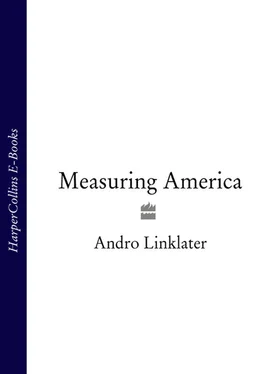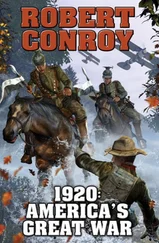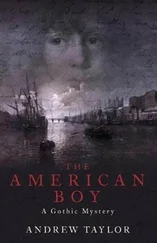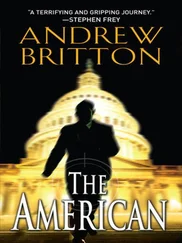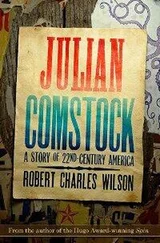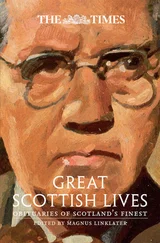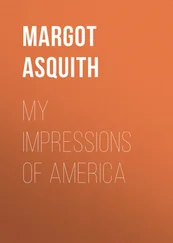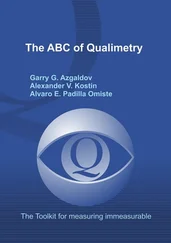Yet nothing could be done until the states agreed to give up individual claims to territory that they had all won from the British. Virginia, for example, as the original colony, had some rights to all the land from Lake Erie west to modern-day Wisconsin and south to St Louis, while Massachusetts could point to a phrase in its charter giving it ‘the mayne Landes from the Atlantick … on the East Parte, to the South Sea [the Pacific] on the West parte’. States like Maryland and New Jersey whose western boundaries had been drawn by surveyors refused even to sign the Articles of Confederation, which bound them to act together against the British, until these gigantic claims had been abandoned.
Although Rufus Putnam seems not to have been aware of it, the key to the deadlock was in the hands of the Arch Enemy. In 1781 Jefferson as Governor had ceded Virginia’s claim to the Western Territory to the Continental Congress. One by one, the other claimant states followed suit, and the Articles of Confederation were at last signed in 1781, shortly before the war ended. But true to his Enlightenment self, Jefferson had added a reservation. Only the United States government could acquire the territory from the native American nations who owned it. Consequently any claims made by pre-revolutionary land companies were cancelled. Congress, however, was filled with company sympathisers. No United States territory could exist until one or other side backed down.
Over the next twenty years Jefferson was to engage in an ideological war with land speculators whose interests were diametrically opposed to his. In the Continental Congress their ringleader was Robert Morris. He had out-manoeuvred Jefferson over Virginia’s disposal of land within her existing boundaries, and was now the Congress’s Superintendent of Finance, an influential position which helped ensure that the congressional mood remained in favour of the land companies.
The two men were polar opposites: Morris, whose fat, friendly, asthmatic appearance distracted attention from a cold, abacus mind, and the lean, controlled, complex Jefferson, concealing his emotional weakness and high-flown idealism behind a stream of words and studied informality. ‘His whole figure has a loose, [shambling] air,’ observed Senator William Maclay of Jefferson in 1790. ‘He has a rambling vacant look, and nothing of that firm, collected deportment which I expected … He spoke almost without ceasing. But even his discourse partook of personal demeanour. It was loose and rambling, and yet he scattered information, wherever he went, and some even brilliant sentiments sparkled from him.’
Unlike Jefferson’s privileged background, Morris’s past was one of unremitting effort from his arrival as a penniless immigrant from England in 1747, through long years as an accountant working for the wealthy Philadelphia merchant Charles Willing, until he was made a partner in Willing’s company, and became one of the wealthiest men in America. During the war he had used his wealth to underwrite contracts for the purchase of supplies and munitions for Washington’s army, and with the goodwill this earned he secured still more profitable contracts for himself.
The second skirmish in Jefferson and Morris’s long campaign occurred over currency.
When George Washington replied to Rufus Putnam in April 1784, his letter illustrated the basic money problem facing the new republic. Pointing out that Congress was still deadlocked on the land question, Washington offered instead to lease his thirty thousand acres in the Ohio valley to the impatient Massachusetts veterans. The rental would be high, about $36 per hundred acres, he explained, because ‘it is land of the first quality’ and the cost of improvements he had made amounted to ‘£1568 Virginia, equal to £1961/3/3d Maryland, Pennsylvania or Jersey currency’. If Rufus was still not sure how much that meant in Massachusetts, Washington added that ‘a Spanish milled dollar shall pass in payment for six shillings’.
The handicap to Washington’s real-estate deal was one that hobbled every commercial transaction in the United States at that time. Although the legal tender remained officially the British pound, divided into twenty shillings, each in turn subdivided into twelve pennies, its value in America differed from one state to the next. The commonest single coin, the Spanish dollar, was worth five shillings in Georgia, but thirty-two shillings and sixpence across the border in South Carolina, and six shillings in New Hampshire, while the official London rate was four shillings and sixpence. Still more confusingly, it was divided into eight bits in Pennsylvania, but contained ten bits in Virginia. Along with Spanish dollars and doubloons, there were also French louis d’or and écus; Portuguese moidores, pistoles and half-Joes, so called because they carried the image of King Johannes V; Dutch florins; Swedish dollars or riksdalers; as well as the sovereigns, shillings and pennies of Britain. Familiarity taught most people to juggle all these currencies, and just as the teenage George Washington casually reckoned up his pay in pistoles and doubloons, so Thomas Jefferson, scribbling a quick note of a sale of land, recorded that the price had been ‘200 [pounds] of which 20 half-Joes are paid’, or $950 and $160 respectively. Opinion in Congress, however, held that a single currency was needed to help hold the new nation together.
The first recommendation came from Congress’s Superintendent of Finance, Robert Morris. It was based on an unrealistically small unit, a fraction of a penny, and in the opening shot of their campaign, Jefferson replied with a report early in 1784 recommending instead the adoption of the Spanish dollar as the most convenient basis of the new currency. In the interests of simplicity he suggested that instead of being divided up into eight bits, it should be decimalised. ‘Every one remembers,’ he told Congress, ‘that when learning money arithmetic, he used to be puzzled with adding the pence, taking out the twelves and carrying them on; adding the shillings, taking out the twenties and carrying them on. But when he came to the pounds where he had only tens to carry forward, it was easy and free from error. The bulk of mankind are school boys thro’ life. These little perplexities are always great to them.’ Accordingly, the dollar should be subdivided into tenths or dismes, hundredths or cents, and thousandths or mills.
It was an argument that everyone could understand, and less than eighteen months later, on 6 July 1785, Congress resolved that ‘the money unit of the United States of America be one dollar’, and that ‘the several pieces shall increase in decimal ratio’. This was not just an intellectual victory for Jefferson; it effectively prevented Morris from achieving his goal of running the United States Mint, a source of potentially enormous profits.
In the course of the currency debate, Morris had declared, ‘it is happy for us to have throughout the Union the same Ideas of a Mile and an Inch, a Hogshead and a Quart, a Pound and an Ounce’. Even without their earlier hostilities, this would have set him on a collision course with Virginia’s representative, for it was clear to Jefferson that the rationale for replacing pennies and shillings with a decimal unit applied equally to American weights and measures.
Officially each state had adopted the system of Troy and avoirdupois that Elizabeth I had imposed on sixteenth-century England and that subsequent legislation in London had amended; but barely a single unit was the same from one state to the next – except for Gunter’s chain and the acre. A Virginia tobacco-grower like Thomas Jefferson measured his crop in hogsheads, well aware that a Virginia hogshead was larger than a New York hogshead but smaller than one from Maryland, and that a tobacco hogshead from any state was a different size to a brewer’s hogshead. A Boston brewer might also refer to his hogshead of beer as a pipe, butt or puncheon, knowing that each of them contained two cooms, four kilderkins, eight rundlets, or sixty-four gallons. But a Baltimore brewer who used the same measures somehow ended up with only sixty-three gallons of beer in his Maryland hogshead, while the number of gallons in a Pennsylvania brewer’s hogshead actually changed depending on where the beer was sold, because the law required innkeepers to sell beer inside the inn by the wine gallon, which was smaller than the beer gallon that was used for selling beer outside the inn. And the confusion over liquid measurements was nothing compared to the labyrinth of quarts, gallons and bushels used for measuring corn or flour. Because of flaws in English legislation, each of them could be one of eight different sizes, and might be measured either heaped above the brim of the container, or struck, meaning level with the brim, as custom or the local market dictated.
Читать дальше
